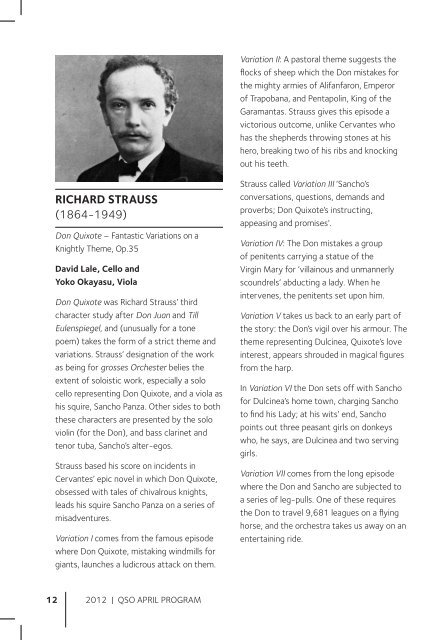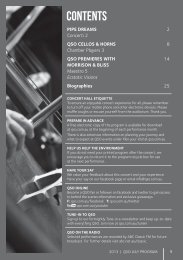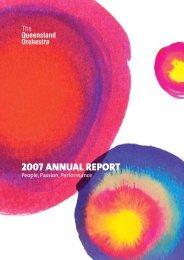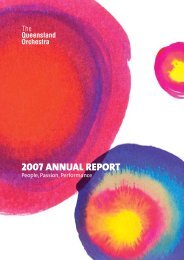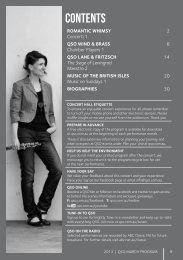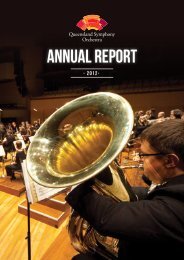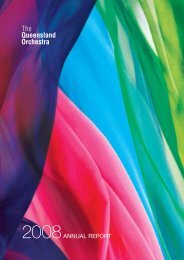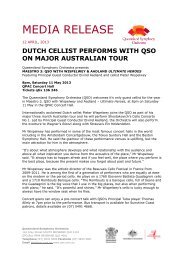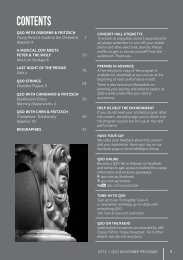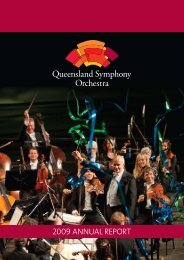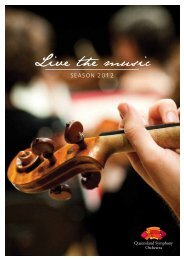April 2012 - Queensland Symphony Orchestra
April 2012 - Queensland Symphony Orchestra
April 2012 - Queensland Symphony Orchestra
You also want an ePaper? Increase the reach of your titles
YUMPU automatically turns print PDFs into web optimized ePapers that Google loves.
RICHARD STRAUSS<br />
(1864-1949)<br />
Don Quixote – Fantastic Variations on a<br />
Knightly Theme, Op.35<br />
David Lale, Cello and<br />
Yoko Okayasu, Viola<br />
Don Quixote was Richard Strauss’ third<br />
character study after Don Juan and Till<br />
Eulenspiegel, and (unusually for a tone<br />
poem) takes the form of a strict theme and<br />
variations. Strauss’ designation of the work<br />
as being for grosses Orchester belies the<br />
extent of soloistic work, especially a solo<br />
cello representing Don Quixote, and a viola as<br />
his squire, Sancho Panza. Other sides to both<br />
these characters are presented by the solo<br />
violin (for the Don), and bass clarinet and<br />
tenor tuba, Sancho’s alter-egos.<br />
Strauss based his score on incidents in<br />
Cervantes’ epic novel in which Don Quixote,<br />
obsessed with tales of chivalrous knights,<br />
leads his squire Sancho Panza on a series of<br />
misadventures.<br />
Variation I comes from the famous episode<br />
where Don Quixote, mistaking windmills for<br />
giants, launches a ludicrous attack on them.<br />
Variation II: A pastoral theme suggests the<br />
flocks of sheep which the Don mistakes for<br />
the mighty armies of Alifanfaron, Emperor<br />
of Trapobana, and Pentapolin, King of the<br />
Garamantas. Strauss gives this episode a<br />
victorious outcome, unlike Cervantes who<br />
has the shepherds throwing stones at his<br />
hero, breaking two of his ribs and knocking<br />
out his teeth.<br />
Strauss called Variation III ‘Sancho’s<br />
conversations, questions, demands and<br />
proverbs; Don Quixote’s instructing,<br />
appeasing and promises’.<br />
Variation IV: The Don mistakes a group<br />
of penitents carrying a statue of the<br />
Virgin Mary for ‘villainous and unmannerly<br />
scoundrels’ abducting a lady. When he<br />
intervenes, the penitents set upon him.<br />
Variation V takes us back to an early part of<br />
the story: the Don’s vigil over his armour. The<br />
theme representing Dulcinea, Quixote’s love<br />
interest, appears shrouded in magical figures<br />
from the harp.<br />
In Variation VI the Don sets off with Sancho<br />
for Dulcinea’s home town, charging Sancho<br />
to find his Lady; at his wits’ end, Sancho<br />
points out three peasant girls on donkeys<br />
who, he says, are Dulcinea and two serving<br />
girls.<br />
Variation VII comes from the long episode<br />
where the Don and Sancho are subjected to<br />
a series of leg-pulls. One of these requires<br />
the Don to travel 9,681 leagues on a flying<br />
horse, and the orchestra takes us away on an<br />
entertaining ride.<br />
Strauss slyly reveals the true state of<br />
affairs (that the flying horse is a toy; that<br />
the impression of wind is really created by<br />
bellows) by continuously sounding a pedal<br />
note of D.<br />
Variation VIII depicts the ‘Enchanted Boat’<br />
which, taken from the riverbank by the Don<br />
and Sancho, drifts towards a weir amidst<br />
some water mills and is smashed to pieces.<br />
In Variation IX, the Don mistakes two<br />
Benedictine monks, whose intense<br />
conversation is conveyed by bassoons, for<br />
sorcerers bearing off a princess.<br />
The final variation follows without a break –<br />
the Don’s battle with the Knight of the White<br />
Moon, fellow-villager Sampson Carrasco,<br />
who, in disguise, hopes to defeat the Don<br />
and in doing so exact a promise from him to<br />
give up his foolish quests and return home.<br />
The orchestra depicts the jousting of the two<br />
contenders, but most graphic and moving is<br />
the Don’s leaden-footed return, a powerful<br />
pedal point reinforced by regular timpani<br />
strokes. The Don considers taking up a<br />
pastoral life (the shepherd’s piping is heard),<br />
but at least the worst of his delusions is over,<br />
and he is becoming restored to clarity.<br />
The work closes with a depiction of Don<br />
Quixote’s death, a moving melody for cello.<br />
Subtle tremors of impending death are heard.<br />
The soloist often ends up slumped over his<br />
cello at the conclusion of the dying glissando.<br />
Adapted from a note by Gordon Kalton Williams<br />
<strong>Symphony</strong> Australia © 1998<br />
12 <strong>2012</strong> | QSO APRIL PROGRAM <strong>2012</strong> | QSO APRIL PROGRAM 13


